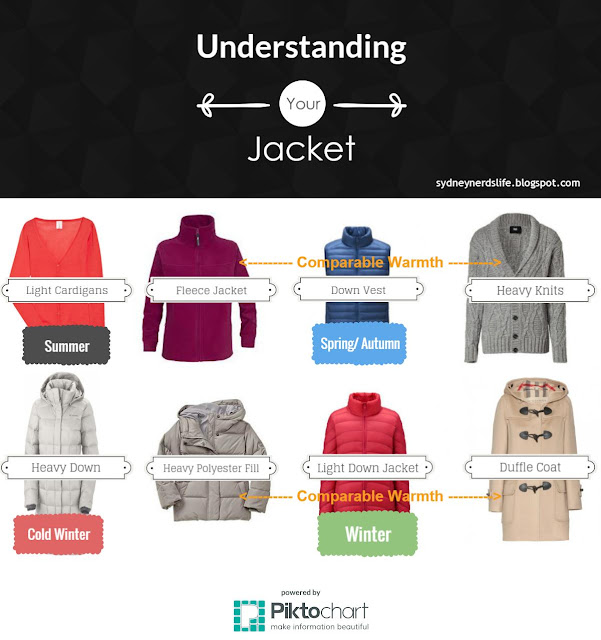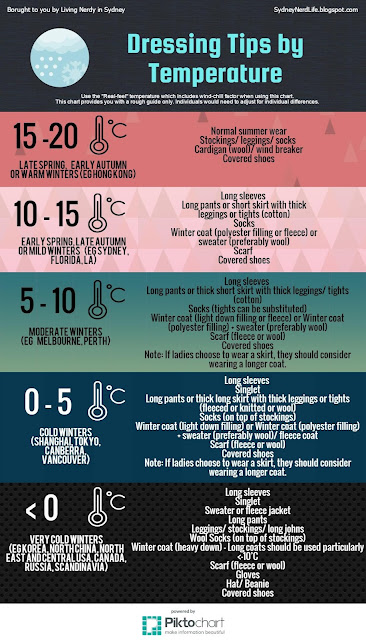How to Dress Warm when travelling to Winter!
Most of us from South East Asia would have never experienced winter in our home countries. Watching snowflakes drift down slowly from the sky is a often a dream for most of us. With travel becoming more and more accessible to the middle class, snow now is just one flight away to a temperate country.
What most of us don't really know is how to dress up to keep warm in winter. It really isn't just about donning on a thick coat. Here are some very helpful tips on keeping warm when you travel.
1. Understand your Jackets
Thickness alone of a jacket doesn't make a jacket warmer. How a jacket is made and the types of materials use is just as important. A warmer jacket is made of materials which trap heat better. For example, a down jacket traps more heat than a polyester filled jacket of the same thickness. For knitted wear, wool is a much better insulator than polyester. Also, the more the jacket covers up, the warmer it is. For example, a long coat is warmer than a vest of the same material.
2. Learn to layer
Just wearing one big coat over a short sleeved t-shirt really doesn't cut it most of the time. You will need to learn the art of layering. Closest to your body you want something clingy but also moisture absorbent. The last thing you want is to start perspiring and get cold as a result. Cotton or polyester long-sleeve t-shirts are among the best options. Wool long johns are normally warmer, but if you are going between in and outdoors very often, this might not be the best choice as you will get very itchy indoors. If you are willing to spend extra cash, try looking for specialized thermal underwear in adventuring shops.
For additional warmth, you can always add a singlet inside or chose clothes with turtle neck or a long sleeve fleece t-shirt. If it is very cold, you should wear a heavy cardigan, knitted jumper or fleece jacket under your overcoat as well.
Don't forget to layer for your legs too. Long johns, leggings, stockings, tights and socks. For ladies, it's perfectly okay to wear both stockings and leggings; or even both stockings and socks.
3. Always wear closed shoes and socks
Living in tropics might mean you have very few closed shoes. However, in winter, it is almost an absolute must to have closed shoes and socks. If it is snowing, you would want to wear shoes with adequate water proofing - so canvas shoes or Ugg boots are not an option. You really don't want to get your feet wet. Sandals and slippers are a big no-no for winter.
If you can afford it, go for a pair of boots. For ladies remember, long boots go with short skirts or leggings; short boots go with long pants or long skirts. Also, even if you wear boots socks or stockings are still a must. If you are on a budget, your leather shoes or sport shoes will do the trick.
4. Check the weather forecast
There are a few things to look out for namely the forecasted temperature both the minimum and maximum temperature, and wind speed and direction. If "real feel" temperature is available, that would be the most reliable to base what you wear on. Apps like AccuWeather (also available online) should show you "real feel" temperature.
Dressing up for a 20'C day is very different from dressing up for a -20'C day. And dressing up for a day with a small temperature range is very different from dressing up for a large temperature range. Wind speed would affect the wind chill factor. Wind direction will affect the temperature of the wind.
As rule of thumb, if the daily range is over 10'C dress focusing on more layers. This is very common in in-land regions as the temperatures are less affected by sea currents. The daily temperature is coldest in the early morning and peaks in the mid afternoon. You want to make sure you have enough layers to add on when the temperature drops at night.
If "real feel" temperature is not available, look at the wind speed and direction. In the northern hemisphere if there is wind from the North (or reverse in the southern hemisphere), it indicates a cold arctic wind. And if the wind over 35 km/h, this means there will be significant wind chill.
5. Understand your travel itinerary
Do some research about the places you are going. If you are going to be spending a lot of time outdoors, you need to be adequately prepared with a warmer coat. If you are going to be taking part in strenuous activities, like cycling or mountain climbing, you may wish to not wear an extra jumper as when you start to perspire, you will feel colder.
If you are going to keep going from indoors to outdoors, like visiting museums or shopping centres, you should focus on wearing multiple layers so that you can take them off and put them back on when you switch from indoors to outdoors. Also, remember when you go indoors, take off your outer coat. It will help you feel warmer when you put it back on when you leave to go out doors. Also, do note in some countries heating may not be as readily available. So do your homework.
6. Protect your extremities with accessories.
Hats, beanies, scarves and gloves are not just fancy accessories. They are important to keeping warm. About 10% of heat loss is through your head, hence a hat and scarf is very important. If you normally wear a religious headgear, opt for one made of wool or fleece.
As for gloves, if you are a smart phone user, you might like to get gloves with special tips to allow you to use your phone. Alternatively, there are convertible gloves with fingers exposed and a cap to turn your gloves into mittens. If you are going to play in snow, make sure you choose waterproof gloves.
7. Don't forget proper sleepwear!
People often forget to pack proper sleep wear when travelling to winter. First, check out the type of heating in your accommodation. If there is no heating, be prepared by bringing along flannel pyjamas. If you don't wish to buy flannel pyjamas just for the trip, a track suit will often do the trick as well. If the night time temperature is less than 0'C, consider bringing a hot water bottle along. Some Airbnbs, hostels or the countryside in some third world nations may not have heating, so be prepared.
If there is heating, particularly central heating or fan heating, make sure you bring along short sleeve and long pants type pyjamas. Fan and central heating is most commonly found in most hotels and hostels, and has the tenancies to be very drying. Leave a cup of water out in the room to increase the room's humidity. Make sure you set the thermostat in the room to around 18'C or you will find yourself waking in the middle of the night feeling too hot.
If there is non-auto feeding wood heating, make sure you have long sleeve pyjamas as the wood would run out in the middle of the night and the room will start becoming very cold. This type of heating is common in the countryside in cabin accommodation.
Good luck to your winter adventures and stay warm!
To subscribe to my blog, please Like on our Facebook page.
To support my blog, please click on one of my sponsor's advertised links :)
What most of us don't really know is how to dress up to keep warm in winter. It really isn't just about donning on a thick coat. Here are some very helpful tips on keeping warm when you travel.
1. Understand your Jackets
Thickness alone of a jacket doesn't make a jacket warmer. How a jacket is made and the types of materials use is just as important. A warmer jacket is made of materials which trap heat better. For example, a down jacket traps more heat than a polyester filled jacket of the same thickness. For knitted wear, wool is a much better insulator than polyester. Also, the more the jacket covers up, the warmer it is. For example, a long coat is warmer than a vest of the same material.
Just wearing one big coat over a short sleeved t-shirt really doesn't cut it most of the time. You will need to learn the art of layering. Closest to your body you want something clingy but also moisture absorbent. The last thing you want is to start perspiring and get cold as a result. Cotton or polyester long-sleeve t-shirts are among the best options. Wool long johns are normally warmer, but if you are going between in and outdoors very often, this might not be the best choice as you will get very itchy indoors. If you are willing to spend extra cash, try looking for specialized thermal underwear in adventuring shops.
For additional warmth, you can always add a singlet inside or chose clothes with turtle neck or a long sleeve fleece t-shirt. If it is very cold, you should wear a heavy cardigan, knitted jumper or fleece jacket under your overcoat as well.
Don't forget to layer for your legs too. Long johns, leggings, stockings, tights and socks. For ladies, it's perfectly okay to wear both stockings and leggings; or even both stockings and socks.
3. Always wear closed shoes and socks
Living in tropics might mean you have very few closed shoes. However, in winter, it is almost an absolute must to have closed shoes and socks. If it is snowing, you would want to wear shoes with adequate water proofing - so canvas shoes or Ugg boots are not an option. You really don't want to get your feet wet. Sandals and slippers are a big no-no for winter.
If you can afford it, go for a pair of boots. For ladies remember, long boots go with short skirts or leggings; short boots go with long pants or long skirts. Also, even if you wear boots socks or stockings are still a must. If you are on a budget, your leather shoes or sport shoes will do the trick.
4. Check the weather forecast
There are a few things to look out for namely the forecasted temperature both the minimum and maximum temperature, and wind speed and direction. If "real feel" temperature is available, that would be the most reliable to base what you wear on. Apps like AccuWeather (also available online) should show you "real feel" temperature.
Dressing up for a 20'C day is very different from dressing up for a -20'C day. And dressing up for a day with a small temperature range is very different from dressing up for a large temperature range. Wind speed would affect the wind chill factor. Wind direction will affect the temperature of the wind.
As rule of thumb, if the daily range is over 10'C dress focusing on more layers. This is very common in in-land regions as the temperatures are less affected by sea currents. The daily temperature is coldest in the early morning and peaks in the mid afternoon. You want to make sure you have enough layers to add on when the temperature drops at night.
If "real feel" temperature is not available, look at the wind speed and direction. In the northern hemisphere if there is wind from the North (or reverse in the southern hemisphere), it indicates a cold arctic wind. And if the wind over 35 km/h, this means there will be significant wind chill.
5. Understand your travel itinerary
Do some research about the places you are going. If you are going to be spending a lot of time outdoors, you need to be adequately prepared with a warmer coat. If you are going to be taking part in strenuous activities, like cycling or mountain climbing, you may wish to not wear an extra jumper as when you start to perspire, you will feel colder.
If you are going to keep going from indoors to outdoors, like visiting museums or shopping centres, you should focus on wearing multiple layers so that you can take them off and put them back on when you switch from indoors to outdoors. Also, remember when you go indoors, take off your outer coat. It will help you feel warmer when you put it back on when you leave to go out doors. Also, do note in some countries heating may not be as readily available. So do your homework.
6. Protect your extremities with accessories.
Hats, beanies, scarves and gloves are not just fancy accessories. They are important to keeping warm. About 10% of heat loss is through your head, hence a hat and scarf is very important. If you normally wear a religious headgear, opt for one made of wool or fleece.
As for gloves, if you are a smart phone user, you might like to get gloves with special tips to allow you to use your phone. Alternatively, there are convertible gloves with fingers exposed and a cap to turn your gloves into mittens. If you are going to play in snow, make sure you choose waterproof gloves.
 |
| Convertible gloves (Source: Aliexpress) |
7. Don't forget proper sleepwear!
People often forget to pack proper sleep wear when travelling to winter. First, check out the type of heating in your accommodation. If there is no heating, be prepared by bringing along flannel pyjamas. If you don't wish to buy flannel pyjamas just for the trip, a track suit will often do the trick as well. If the night time temperature is less than 0'C, consider bringing a hot water bottle along. Some Airbnbs, hostels or the countryside in some third world nations may not have heating, so be prepared.
If there is heating, particularly central heating or fan heating, make sure you bring along short sleeve and long pants type pyjamas. Fan and central heating is most commonly found in most hotels and hostels, and has the tenancies to be very drying. Leave a cup of water out in the room to increase the room's humidity. Make sure you set the thermostat in the room to around 18'C or you will find yourself waking in the middle of the night feeling too hot.
If there is non-auto feeding wood heating, make sure you have long sleeve pyjamas as the wood would run out in the middle of the night and the room will start becoming very cold. This type of heating is common in the countryside in cabin accommodation.
Good luck to your winter adventures and stay warm!
To subscribe to my blog, please Like on our Facebook page.
To support my blog, please click on one of my sponsor's advertised links :)






One of my best buddies recommended this website and I owe it to her. She helped me to find this nice website. I appreciate your nice work. Keep continuing helping others. I will refer this site to other people like my best buddy. Thanks.
ReplyDeleteHug & blesses!
Click this post to read more.
This is the type of information I’ve long been trying to find. Thank you for writing this information. Custom Patch Maker
ReplyDeleteThis is such a helpful post, especially for someone like me who tends to underestimate how cold it can get when traveling! I loved your layering tips—they're practical and stylish. I recently discovered the IBC heater jacket, and it's been a total game-changer for staying warm without the bulk. Thanks for sharing your experience; I’ll definitely be revisiting this before my next winter trip!
ReplyDelete